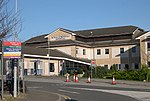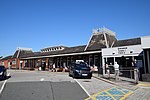Penweathers
Carrick geography stubsHamlets in Cornwall

Penweathers is a hamlet in west Cornwall, England, United Kingdom. It is approximately one mile (1.6 km) west of Truro city centre.The West Cornwall Railway opened the Penwithers railway viaduct on 17 December 1887. Constructed of granite from the quarries at Carn Brea. It consists of seven arches with a total length of 420 feet (130 m). With a uniform width of 24 feet (7.3 m), it was designed for a possible upgrade to two lines, if needed in the future.
Excerpt from the Wikipedia article Penweathers (License: CC BY-SA 3.0, Authors, Images).Penweathers
Truro Highertown
Geographical coordinates (GPS) Address Nearby Places Show on map
Geographical coordinates (GPS)
| Latitude | Longitude |
|---|---|
| N 50.25483 ° | E -5.07912 ° |
Address
TR3 6EA Truro, Highertown
England, United Kingdom
Open on Google Maps









